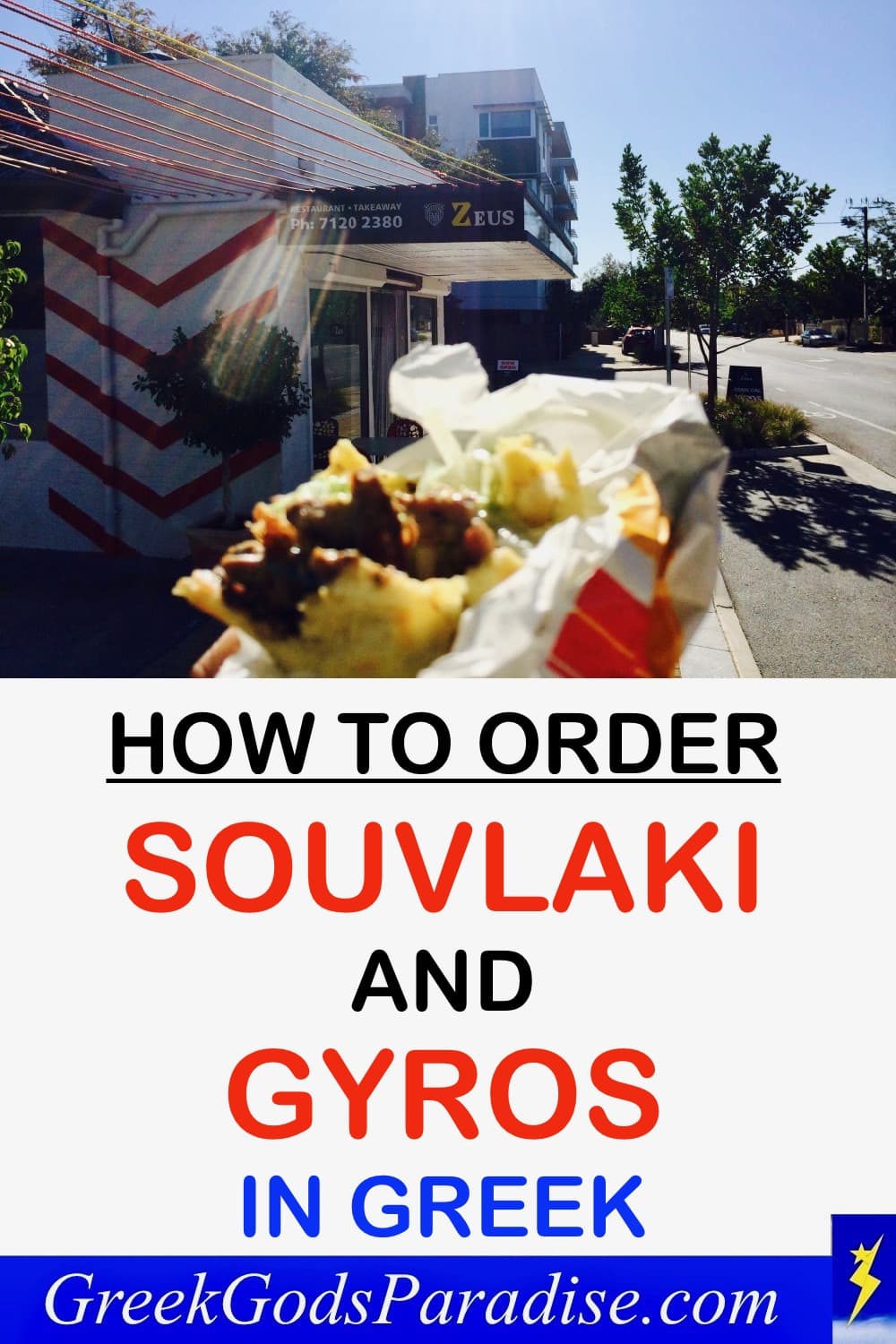Greek lesson 7 teaches you how to order souvlaki and gyros in Greek as if you were born and bred in Greece.
In this Greek-speaking lesson you will learn:
- the difference between Greek souvlaki and gyros (in different parts of Greece).
- different ways of serving souvlaki and gyros in Greece.
- and how to speak Greek when ordering gyros and souvlaki – the most important part.
Tasting authentic Greek souvlaki or gyros would have to be one of the best things to do in Greece.
And in my opinion, it has to be the number 1 thing to do in Greece for foodies.
So learning how to order souvlaki and gyros in Greek will add tremendously to your overall food tasting experience in Greece.
Give it a go and see what happens.
Before starting the Greek-speaking lesson, let’s first learn a bit more about souvlaki and gyros (yiros).
The difference between Souvlaki and Gyros
Believe it or not but souvlaki and gyros can mean different things depending on which part of Greece you are in.
Gyros by the way means “turn” in Greek, which is what happens when the meat slowly cooks as it turns around on a vertical rotisserie.
Traditional souvlaki meat is generally grilled horizontally and rotated over a charcoal fire to give it a great tasting flavor.
Marinated small chunks of souvlaki meat are threaded onto sticks/skewers when grilled.
Sometimes, you may even find souvlaki meat and vegetables grilled together on skewers/sticks.
You will find that the meat is always grilled until it is well done.
Souvlaki meat is considered a healthier option compared to gyro meat because there is less oil in its marination.
You will commonly eat souvlaki right off a wooden stick, but you can also eat it wrapped in pita bread if you request it that way.
I can’t see why you would when you could have a meal that looks as good as this.

At one particular Greek Festival known as the Blessing of the Waters, you can see another delicious-looking souvlaki meal, which I ate at the beach.
Souvla means skewer, so you can see how souvlaki obtained its name.
The four main variations of souvlaki and gyros in Greece include:
- Pork stick
- Chicken stick
- Pork yiro
- Chicken yiro
Souvlaki and Gyros in Athens (and southern Greece)
In Athens, gyros (pronounced: yee-ros) refers to meat cut from a vertical rotating rotisserie.
The delicious meat is often eaten with some salad including tomatoes, onions, a few potato chips, and some tzatziki sauce, all wrapped in lightly grilled pita bread.
In Athens and southern Greece, meat cooked on skewers is known as Kalamaki.
Kalamaki, by the way, is derived from the Greek word for small reed.
Souvlaki is the Greek word for “skewer,” so I can understand if you are a bit confused.
Note: In countries like Australia, meat grilled on skewers is always known as souvlaki.
Souvlaki and Gyros – Thessaloniki (Macedonian region)
To add to the confusion, souvlaki is how meat cooked on wooden sticks/skewers is known in Thessaloniki, which is Greece’s second-largest city.
Meat on sticks (skewers) is also known as souvlaki in the Macedonian region of Greece.
When ordering gyros in Thessaloniki, it most likely means you would like the meat cooked on a vertical rotating rotisserie.
The other thing to remember is that in Thessaloniki, you can order gyros as a portion or sandwich (pronounced: sand-wits in Greek).
Having it as a gyro sandwich is the equivalent of having souvlaki (wrapped in pita bread) in Athens.
In Athens (and in general the Greek islands), it is almost never called a sandwich.
Souvlaki and Gyros meat used in Greece
In Greece, you will find that souvlaki meat and gyros meat is either pork or chicken. These are the most common choices available.
Not sure how hard it would be to find lamb souvlaki in Greece, but it will probably be difficult to find.
Interestingly, in countries like Australia, it is most common to order and eat lamb gyros.
Souvlaki and Gyros: Greek Speaking Lesson
Now let’s begin the main Greek lesson, teaching you how to order souvlaki and gyros in Greek.
Just speak the words shown in blue and red text as an English speaker would when reading the words.
Make sure you read it out loud. By reading it out loud, you will be speaking Greek in no time. So let’s begin.
I’d like, a, souvlaki, with everything, please
Tha ithela, ena, souv-larki, arp-ola, para-kar-lor
Tha ith-ella, ena, soov-larh-kee, arp-ola, pa-ra-ka-lor
If you just ask for “Souvlaki” it is unclear whether you want to have a stick or with pita.
There’s nothing wrong; you’ll just have a more extended conversation with the waiter. Because he’ll ask, “Kalamaki I Pita?” (Stick or Pita).
However, we also said “With everything” which is ap’ ola in Greek.
People who take your order will commonly ask you this clarifying question “with everything?” especially if you didn’t say it yourself. So it’s important to remember.
Since you’ve said “Ap’ ola,” it means that you’d like it with pita. That is because a souvlaki stick never comes with anything extra since it is just plain meat. Therefore, it’s safe to say that you’ll get a pita.
However, since you haven’t defined the kind of meat you want, the waiter will most likely ask: “Kotopoulo i Hirino?” meaning Chicken or Pork?
You could then ask for one of the four main varieties: Kalamaki Kotopoulo (using Chicken meat grilled on a stick), Kalamaki Hirino (using Pork meat grilled on a stick), Gyro Kotopoulo (Chicken Yiro), or Gyro Hirino (Pork Yiro).
Note: If you wanted to order souvlaki meat from a stick/skewer wrapped in pita, you would ask for Kalamaki Kotopoulo (or Hirino) wrapped in Pita. Meat wrapped in Pita, doesn’t only have to be Gyro meat. You can also have meat grilled on sticks (minus the sticks of course in the pita bread).
If you order “Ena Kalamaki Ap’ola” it means that you want a Kalamaki in Pita.
You can also add your meat preference “Ena Kalamaki Hirino Ap’ola” to avoid being asked about your meat preference.
If you order “Ena Kalamaki” without adding anything more, you will get meat on a stick/skewer. Kalamaki doesn’t (usually) come with anything on the side (perhaps a slice of bread).
I want, a, souvlaki
Thelo, ena, souvlaki
Thelo, en-na, souv-larki
Most Greeks would probably prefer to say “Tha ithela” (I would like …) as shown above, rather than “Thelo ena” (I want a …).
However, you can also say it this way if you prefer.
A, pork gyros, with everything, please
Mia, pita me yee-roh hir-rin-or, arp-arl-or, para-kar-lor
Mee-a, pita meh yee-ror hir-in-or, arp-arl-or, pa-ra-karl-or
To make it clearer, you could say something a bit simpler like this.
You could also say “Pita Yee-ror” instead of “Pita meh Yee-ror.”
The shorter way is the most common, and George always goes with the shorter option. However, some people always ask for Pita Me Gyro.
I’d like, a, chicken gyros (wrapped in pita), please
Tha ithela, mia, pita yee-ror, cortor-poul-or, para-kar-lor
Tha ith-ella, mya, pita yee-ror, cort-or-poul-oh, pa-ra-ka-lor
For some reason, the Greeks say the meat choice (eg. chicken in this case) after the Greek word for gyros (yee-ror).
Note: Chicken in Greek is pronounced as cortor-poul-or.
Important note: Pita Gyro has no plural version, so it is Ena Pita Gyro Kotopoulo, and also the same for two (or more) Pita Gyro Kotopoulo. However, souvlaki would end up changing to souvlakia.
gyros (yiros)
Yee-ror
Yeee-ror
Pita Yiro or Meritha Yiro is all you really need to know.
Souvlaki / Gyros (wrapped in pita)
Pita meh Souvlaki / Pita Yee-ror / Pita meh Yee-ror
Pita meh Souv-laki / Pita Yeee-ror / Pita meh Yee-ror
A common way of asking for a gyro in Athens is asking for “Pita meh Souvlaki.”
To avoid a longer talk, you can choose your meat preference after souvlaki (Pita Meh Souvlaki Kotopoulo, for example).
You could also say “Souvlaki meh pita.”
You can say “Pita souvlaki,” just add Kotopoulo or Hirino afterward.
Another common shorter way is “Pita yee-ror.”
You can say Mia Pita meh Gyro or Ena Pita meh Souvlaki. Both are fine to use.
Pita Yiro is always about the wrapped-in-pita souvlaki.
When you want to have it with Pita, ideally you should always define it, which is why you see the word “pita” being used in both “Souvlaki me pita” and “Pita yee-ror.”
When ordering your gyros, you can also say the kind of meat you want.
For example, a typical way to order a pita is “Tha Ithela Ena Pita Gyro Kotopoulo” (I’d like one Pita Gyro Chicken).
As you can see, by saying it this way, you don’t even have to say the word “souvlaki” because Pita and Gyro are enough.
George’s Tip: The slang for the Pita Gyro is Pitoyiro. When you are out with friends and talking with them, you can always say, “Pame Yia Ena Pitoyiro?” (Let’s go for a gyros).
Note (for above): Yia is pronounced Ya, in the same way as Greek greetings like Ya-soo and Ya-sas. Ena is used like the letter “a” in English in this sense. Despite using the same word, it doesn’t translate to “One” Gyros even though the word “Ena” is the same.
If your friends say “Pame Yia Souvlaki,” it means that everybody wants to eat souvlaki. When ordering, one may say “Ena Kalamaki Kotopoulo” while the other might order “Ena Pita Yee-ror Hirino.”
Type of meat in Souvlaki and Gyros
Pork meat (from pigs) and chicken are the two common meat varieties in Greece when ordering souvlaki and gyros (yiros).
However, you may also find lamb on occasion in Greece. Beef is almost never used to make gyros or souvlaki.
pork
hih-ri-nor
hiri-nor
Pork is the most common meat used to make souvlaki and gyros.
chicken
cort-or-poul-or
cortor-poul-oh
Chicken gyro is gaining popularity because it is assumed to be a lighter and healthier option.
lamb
arr-nark-i
arr-narki
Lamb is generally not available as souvlaki and gyros in Greece.
If you’re craving lamb yiros (gyros) go to Australia.
beef
voth-in-or krey-as
voth-in-or krey-ass
Beef is another meat that you will not typically find in souvlaki and gyros.
Greek Souvlaki and Gyros: Salad Ingredients
When ordering Greek souvlaki or gyros you will often get it with a bit of salad.
tomato, lettuce, onion
torm-mata, ma-roul-i, krem-mithi
torm-art-a, ma-rouli, krem-mith-i
without, onion
hor-ris, krem-mithi
hor-rees, kem-mith-i
If you don’t want onion, just say so. Horis (hor-rees) means without.
potato chips (aka French fries/Greek fries)
pa-tart-es ti-garn-it-es
par-tart-es ti-garn-it-ez
Potato chips in Greece are like French fries, but way-way better.
With or without potatoes: with (meh) or without (hor-ees) pa-tart-es.
with everything
arp-ola
arp-orla
You may hear this word from the waiter/server/cook, asking whether you would like everything with your souvlaki/gyros order.
As you already know, you can also say it yourself when ordering.
“Ap’ ola” literally means “with everything”.
Usually, “Ap’ ola” means everything including tzatziki, french fries, tomato and/or salad, onions, etc.
Usually you’ll also get French fries (chips) inside your wrapped gyros, so don’t be surprised by it.
It depends on where you’re eating, but these are the most common ingredients.
Souvlaki and Gyros: Common Sauces
You should know about a few popular choices for sauces when ordering souvlaki and gyros.
tzatziki
tsah-zee-key
zzazziki
The word starts off sounding more like “Tsah” rather than “Zat”
Imagine it sounding more like the double Z in pizza. So it will be like “Zzazziki” with the pizza pronunciation.
Tzatziki is the most popular Greek sauce. It goes well with pork souvlaki and gyros.
The sauce is a white sauce made with yogurt, cream, cucumbers, and fresh herbs, including mint, garlic, and olive oil.
Note: You will probably get a mayonnaise/mustard-based sauce if you order chicken.
with, tzatkiki sauce
meh, tsah-zee-key
meh, zzazziki
Shown with the word ‘with’ should you prefer to say it this way.
yogurt
yah-oorrr-ti
yah-oorrr-ti
Yogurt is another option as a sauce.
Tip: Going with yogurt could be a wise choice if you’re on a date since yogurt has a similar taste without the added garlic. Most places have it, but you may struggle to find it on the menu. Just ask for it if you want it.
sauce
sohs
soss
You may also hear it pronounced as sarl-tsa. Be careful not to confuse it with salt since it sounds very similar to the English word for salt. But salt in Greek is pronounced ah-las.
Soss is definitely the most common way to say sauce in Greek. Saltsa is becoming rarer in fast-food slang.
Interesting note: On the Greek island of Corfu, a unique tomato sauce, named “red sauce,” is applied to pita Gyros.
How to order souvlaki in Athens, Greece (an example)
When you order souvlaki in Athens, with pork wrapped in pita bread, the conversation between you and the server/cook may go something like this.
What, would you like, please (Server)
Ti, thel-et-e, para-kalo
Ti, thel-et-e, pa-ra-karl-lor
I’d like, a, souvlaki (with pita), please (You say)
Tha ithela, mia, pita yee-ror, para-kalo
Tha ithela, mya, pita yee-ro, pa-ra-kar-lor
This is the way you would say it if you want it wrapped in pita bread.
Important note: In this case, you are asking for one Souvlaki, but if you ask for two (or more), then it becomes Souvlakia.
pork or chicken? (Server says)
hirin-or, i, cortor-poul-or
hiri-nor, i, cort-or-poul-loh
Pork and chicken are the most common meats used when ordering souvlaki or gyros.
pork, please (You say)
hirin-or, para-kalo
hiri-nor, par-ra-kar-lor
Would you like, something else? (Server says)
Thel-et-e, kart-i ar-lor
Thel-et-e, karti arlor
Yes, a portion, of, French Fries, please (You say)
Neh, mia meritha, pa-tart-es tig-arn-it-es, parakalo
Neh, mya meritha, par-tah-tes ti-gah-nee-tes, pa-ra-kalo
A portion is the term used by Greeks when ordering chips.
Interestingly, if you place an order for Greek French fries as an individual order, you will normally get your chips before your main hot meal. The reason why is that chips are considered appetizers in Greece.
Anything to drink? (Server says)
Tha pi-ee-te kati
Tha pi-ee-te kati
You may hear this from the person serving you, especially when placing an order for food over the phone.
Anything to drink? will usually be “Tha pi-ee-te kati?”
Tha pi-ee-te kati? directly translates to something like “Something to drink?”
It is the formal way of saying it.
The plural form of verbs when addressing many people or showing respect to a single individual may affect how you want to say it.
For instance, if someone wants to be more easygoing, such as when two women of a similar age are speaking to one another, then one of them could easily use the singular “Tha pi-ee-s kati?”
Initially, “Tip-orta ya na pi-ee” was used in this lesson for “Anything to drink?”
George clarified that it still made sense, and everybody would understand it, however the usual way of saying it would be “Tha pi-ee-te kati?”
Also, a, can of, Coke, thanks (You say)
Epis-iss, ena, kou-tarki, Corka Corla, ef-har-ist-or
Epis-iss, ena, kou-tarki, Corka Corla, ef-har-isto
If you feel like a beer instead, you can say: keh mia beer-a (and a beer)
Other options include having a glass (pot-iri) of coke or a bottle (bouk-ali) of coke.
Ordering meat on skewers in Athens, Greece
If you love eating juicy delicious meat cooked on skewers then you will want to know how to order it in Greek.
Remember, in Athens, meat on a stick is generally known as kalamaki.
Ordering a portion of kalamaki will usually give you 2-4 skewers.
The original souvlaki is always the stick. In Athens, it is called Kalamaki. In Greek, Kalami is the skewer, and a small skewer is Kalamaki.
Think of Souvlaki as a sort of an umbrella term that refers to both Pita and Kalamaki.
Here we learn how to order the Kalamaki version of Souvlaki.
One, souvlaki on a stick, please
Ena, kalamaki, para-karl-or
En-na, karla-marki, parakalo
By saying this, you’ll hopefully get delicious souvlaki meat on one single wooden stick.
I’d like, two, pork sticks, please
Tha ithela, thee-or, kala-maki-a hir-rin-or, para-karl-or
Tha ith-ella, thee-o, karla-markia hir-rin-or, parakalo
You’d think that the meat choice would come first before saying the Greek word kalamakia, but Greeks say (pork or chicken) after kalamakia.
Important note: When ordering two or more, you say Kalamakia. That’s the plural.
Equally, it is Ena Souvlaki, but two (or more), and then it becomes Souvlakia.
Pita Gyro has no plural version, so it is Ena Pita Gyro Kotopoulo, and also the same for two (or more) Pita Gyro Kotopoulo.
I’d like, three, chicken skewers (sticks), please
Tha ithela, tree-a, kalamaki-a cortor-poul-or, para-karl-or
Tha ith-ella, tree-a, karla-markia kort-or-poul-or, para-kalo
Tips when ordering Souvlaki and Gyros
Tylichto (which sounds similar to Tyl-lick-tor) is just another way of saying Pita Gyro. It translates to Wrapped. It’s another common way of asking for a Pita Souvlaki. It’s “Ena Tylichto,” but thee-o (2) or more and it becomes Tylicht-a.”
Ordering Meritha Gyro is the way to go if you want to sit down and enjoy your meal at a table.
Meritha Gyro is basically gyros on a big plate, with salad and fries on the side, though the cost will be higher. So, if you order your meal as meritha, it could possibly be at least double the price of wrapped souvlaki.
For instance, if a Pita Gyro costs around 3 euros, then a Meritha Gyro could cost you three times as much.
You can order it by saying “Meritha Gyro” or “Gyro Meritha.” Both are fine.
In spoken Greek, it is more typical to order it as “Mia Meritha Gyro” (Mia defines the female word Meritha). But the other version is not wrong.
You may notice that on menus or blackboards with the day’s menu, to save some space, they often write Gyro Meritha.
Some restaurants serve a so-called skepasti. It is similar to a club sandwich (using pita bread), that contains gyros meat, etc. It’s served with fries.
Children will possibly enjoy their meal better if you place the order as pediko, which means without tzatziki and onions.
Kontosouvli is usually Hirino meat which requires another way of preparation. Konto means short, and Souvli derives from Souvla, which is typically a metal skewer. It’s very traditional during Easter, and not that common in souvlaki (you can find it, of course). The meat is definitely softer and juicier. Paprika is also often included between the meat slices so that it can become even juicier.
Pita Gyro is usually wrapped up in paper or aluminum foil.
Sto Héri (Stor Hyeri) – literally means ‘in hand.’ By saying this your souvlaki will be takeaway. You are also letting the server know that you’ll be eating it straight away. Therefore you will receive it partially wrapped.
Se Paketo – “Se Paketo” is used exclusively for takeaway food. Indeed, for any number of Souvlaki (sticks, Pita, etc.) that you want for takeaway, you ask for them “Se Paketo.” You can take it away, possibly in a bag.
Ordering many souvlaki (like ten)
If you mass order souvlaki, you could say “Theloume Deka (10) Souvlakia: Thee-o (2) Kalamakia Kotopoulo, Pente (5) Pita Gyro Hirino, Kai Tria (3) Pita Gyro Hirino horis (without) Tzatziki.”
Kalamaki or Gyros – Which is better?
Kalamaki meat is considered to be better quality than Gyros meat, and it’s always grilled the moment you ask for it.
Gyros is very popular, but it can be given to you from the previous day, as they heat it up again. However, generally speaking, Gyros is tastier.
The price is the same, as long as you ask for Pita. It doesn’t matter if you have it with Kalamaki or Gyros.
Ordering Souvlaki and Gyros – Conclusion
That’s a wrap for this Greek lesson on how to order gyros and souvlaki in Greek.
In this lesson, you have improved your Greek language skills and gained a better understanding of Greek gyros and souvlaki.
Key Greek words/phrases/sentences taught in LESSON 7: 30
Greek lesson 7 has taught you how to order delicious Greek food, so try it out in Greece.
Total number of key Greek words/phrases/sentences from all lessons so far: 180
Another useful Greek Lesson you need to master is lesson 1, which focuses on how to say Greek greetings.
Remember, if a waiter approaches you when you’re sitting at a table, a standard polite Greek greeting is “yasas.” Learn more about it in Greek lesson 1.
Thanks to George for his input into this Greek Lesson
If you want to discover great travel tips for Greece then George has a post about it on Letters to Barbara.
I’m sure George would agree that one of the best travel tips for Greece would have to include learning how to speak some Greek before you visit.
And it has been accomplished by another great Greek lesson made with George’s excellent contributions.

Now we can order souvlaki in Greek without having to speak any English.
Thanks again to George from Letters to Barbara.
Pin it … Share it






